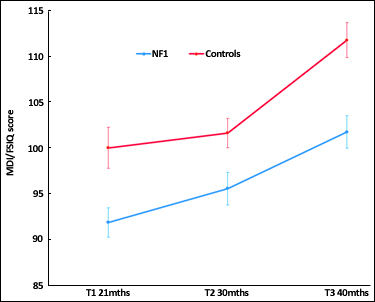


Posted September 23, 2015
Kathryn North, M.D., Children's Hospital at Westmead, Sydney, Australia
 Neurofibromatosis type 1 (NF1) is a genetic disorder affecting 1 in 3000 individuals that is characterized by certain physical manifestations, including changes in skin pigmentation (café-au-lait spots) and growth of neurofibromas, which are benign tumors usually located on or just under the skin. Cognitive deficits are one of the most common childhood complications of NF1, which present as a significant challenge to clinicians. These deficits manifest in a variety of ways and include academic failure due to intellectual impairment or specific learning disabilities, attention deficit hyperactivity disorder and psychosocial maladjustment. These deficits can have a lifelong impact on the individual and contribute to being unable to complete higher education, limitation of career choice, low self-concept and social difficulties. Very little is known about the cognitive development of younger children with NF1. Early identification of children with NF1 at risk of academic failure it is important so that interventions can be implemented early. The longer children with reading disabilities are not identified, the more difficult the task of remediation.
Neurofibromatosis type 1 (NF1) is a genetic disorder affecting 1 in 3000 individuals that is characterized by certain physical manifestations, including changes in skin pigmentation (café-au-lait spots) and growth of neurofibromas, which are benign tumors usually located on or just under the skin. Cognitive deficits are one of the most common childhood complications of NF1, which present as a significant challenge to clinicians. These deficits manifest in a variety of ways and include academic failure due to intellectual impairment or specific learning disabilities, attention deficit hyperactivity disorder and psychosocial maladjustment. These deficits can have a lifelong impact on the individual and contribute to being unable to complete higher education, limitation of career choice, low self-concept and social difficulties. Very little is known about the cognitive development of younger children with NF1. Early identification of children with NF1 at risk of academic failure it is important so that interventions can be implemented early. The longer children with reading disabilities are not identified, the more difficult the task of remediation.
In 2003, Professor Kathryn North of The Children's Hospital at Westmead, Sydney, Australia received a Neurofibromatosis Research Program (NFRP) Fiscal Year Investigator-Initiated Research Award to identify and characterize early predictors of cognitive dysfunction in NF1 and, subsequently, develop a screening tool for health professionals to assist in the early identification of cognitive deficits. The study team consisted of investigators Drs. Kathryn North, Shelly Hyman, Arthur Shores, Jennifer Janusz, Tena Rosser, Penny Glass, Roger Packer, and Belinda Barton. If successful, the results of this study would provide the basis for future development of guidelines for assessment of NF1-specific cognitive deficits and for a rational approach to the development of remediation programs for children with NF1.
In order to accomplish the goals of the study, Dr. North and her team followed children with NF1 from infancy to 7 years of age and evaluated their neurodevelopment and cognitive functioning over this period. Children of the same age, without NF1, were also recruited to the study to serve as a control group. By taking a longitudinal, developmental perspective, the investigators are hoping to identify early predictors of future cognitive deficits thus allowing for the early detection of 'at risk factors', appropriate and timely assessment, and early intervention.
Although the NFRP Fiscal Year 2003 funding for this award ended in May 2008, the investigators have continued to collect data so that all children will be followed until they are 7 years of age. They have recently published some of their NFRP-funded results including a longitudinal study of the cognitive development and behavior of young children with NF1 in the April 2015 edition of the Journal of Pediatrics. In this study, children with NF1 were assessed at 21, 30 and 40 months age and their performance was compared to an age- and gender-matched group of -children without NF. Analyses were conducted to determine whether functioning at earlier time points was predictive of later functioning. Dr. North and colleagues showed that mental development scores at 30 months of age had a greater influence in predicting later intelligence at 40 months of age than the mental development score at 21 months of age. The team also demonstrated that productive vocabulary at 30 months was a significant early predictor of subsequent language performance in children with NF1. It was also found that over time, children with NF1 consistently displayed significantly lower cognitive functioning than healthy controls.

Dr. North's team also compared the cognitive abilities of 3 year old children with NF1 to healthy children who were matched by age, gender and socioeconomic status - variables known to influence cognitive outcomes. By utilizing such a matched case-control design this enabled them to identify differences in cognitive performance that were more likely to be due to the presence of the NF1 gene.
Results indicated that preschool aged children with NF1 had significantly poorer general intelligence, expressive language, visual perception and pre-literacy skills than children without NF. The team also found that performance on expressive language and visual perception tasks were most likely to distinguish young children with NF1 from unaffected children.
These studies demonstrate that children with NF1 demonstrate cognitive difficulties at an early age and 2 years of age may be the appropriate time to perform an initial developmental assessment. Earlier mental function and productive vocabulary are significant predictors of subsequent general intelligence and performance on language measures in children with NF1. This provides an opportunity for early identification and treatment for young children with NF1 who may show signs of impairments in these developmental domains. As school aged children with NF1 are at increased risk for cognitive and academic impairments, monitoring their developmental function from early childhood to late childhood is crucial for their development. Dr. North and her team are continuing to follow the cognitive development of children with NF1 to school age.
Publications:
1. Lorenzo J, Barton B, Arnold SS, North KN (2015) Developmental trajectories of young children with neurofibromatosis type 1: a longitudinal study from 21 to 40 months of age. J Pediatr 166(4):1006-12
2. Lorenzo J, Barton B, Arnold SS, North KN (2013) Cognitive features that distinguish preschool-age children with neurofibromatosis type 1 from their peers: a matched case-control study. J Pediatr 163(5):1479-83
3. Lorenzo J, Barton B, Acosta MT, North K (2011) Mental, motor, and language development of toddlers with neurofibromatosis type 1. J Pediatr 158(4):660-5
Links:














